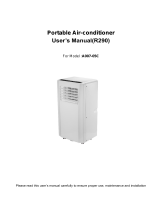
A5P | 01
RISK OF PERSONAL INJURY.
Always locate your appliance away from the edge of
any worktop, on a rm, at, heat-resistant surface with
sucient space around all sides.
Ensure that the appliance is at room temperature before
operating.
The appliance is not intended to be operated by means
of an external timer or separate remote-control system.
When using for the rst time, your appliance may give
o a ‘new’ smell and/or smoke. This will dissipate after
a few uses.
Keep hair, loose clothing, ngers, and all parts of body
away from openings and moving parts.
Do not insert any object into openings or cover the
appliance.
Do not obstruct the air inlets/outlets of the appliance.
Do not use in the following locations:-
- Next to a source of re
- An area where oil is likely to splash
- An area exposed to direct sunlight
- An area where water is likely to splash
- Laundry or wet rooms where the humidity is higher
than 85% RH.
- Near a bath, shower or a swimming pool
- In a greenhouse
- An area where ammable gases or liquids are present
Do not dry laundry above the unit to prevent water
entering the Dehumidier.
Do not use in laundry rooms.
Position the unit so the plug is easily accessible.
Do not lift or move the appliance whilst in use.
Do not sit or stand on the unit.
Do not leave the appliance unattended when
plugged in. Unplug from outlet when not in use, and
before performing user maintenance, connecting or
disconnecting attachments or changing accessories.
Do not use means to accelerate the defrosting process.
Do not operate continuously for periods longer than
those marked on the product or indicated in the
instructions.
Do not lubricate any parts, or carry out any maintenance
or repair work other than that shown in this manual, or
as advised by the DOMU Brands Customer Services.
Use only as described in this manual and do not exceed
maximum capacity (2L).
The appliance shall be stored in a room without
continuously operating ignition sources (for example,
open ames, gas appliances and electric heaters).
Store so as to prevent mechanical damage from
occurring.
Do not pierce or burn.
Be aware that refrigerants may not contain an odour.
The appliance should be installed, operated and stored
in a room with a oor area lager than 4m2.
The appliance shall be compliant with the national gas
regulations.
Servicing shall be performed only as recommended by
the manufacturer.
Any person who is involved with working on or breaking
into a refrigerant circuit should hold a current, valid
certicate from an industry-accredited assessment
authority which authorises their competence to handle
refrigerants safely in a accordance with an industry
recognised assessment specication.
Servicing shall only be performed as recommended by
the equipment manufacturer. Maintenance and repair
requiring the assistance of other skilled personnel,
shall be carried out under the supervision of the person
competent in the use of ammable refrigerants.
Use only DOMU Brands recommended attachments.
The appliance is lled with ammable gas R290.
Any repairs that are needed, please contact the
nearest authorized service centre and strictly follow
manufacturer’s instructions only.
Failure to follow these instructions will invalidate any
warranty.
Energy/Safety protection
Do not cover or restrict the air ow of the inlet/outlet
grills.
For maximum performance ensure the minimum
distance from walls or objects is be 20cm to ensure air
circulation.
Keep lters and grills clean.
When in use do not open windows or doors. Place the
unit of a hard/at
WARNING FOR DISPOSAL:
It is prohibited to dispose of this appliance in domestic
household waste for disposal there are several
possibilities
1 Do not dispose this product as unsorted municipal
waste. .Collection of such waste separately for special
treatment is necessary.
2 The municipality has established collection
systems,where electronic waste can be disposed of at
least free of charge to the user.
3 The manufacturer will take back the old appliance for
disposal at least free of charge to the user.
4 As old products contain valuable resources. They can
be sold to scrap metal dealers..
Wild disposal of waste in forests and landscapes end
angers your health when hazardous substances leak
into the ground-water and nd their way into the food
chain meaning of crossed out wheeled dustbin. Do not
dispose of electrical appliances as unsorted municipal
waste,use separate collection facilities contact you local
government for information regarding the collection
systems available If electrical appliances are disposed
of in landlls of dumps. Hazardous substances can
leak into the groundwater and get into the food-
chain,damaging your health and well-being.
The dehumidication capacity is rated at a room
temperature of 30℃ with a relative humidity of 80%.
If specications are improved after this pointing, the
product nameplate will reect the new specications.
The operational temperature is in the range of 7℃ to
35℃ and max relative humidity of 80%. If the room
temperature is outside of this range, the unit will not
operate normally. GWP value of R290
Refrigerant is 3.
TECHNICAL SPECIFICATION
Rated Voltage: 220-240V~
Rated Frequency: 50Hz
Rated Input Power: 365W
Dehumidify Capacity: 20L (30ºC,RH80%)
Refrigerant: R290/65g
Permissible Excessive
Operating Pressure:
(Suction) 0.7MPa
(Discharge) 3.2MPa
Max Allowable Pressure: 3.2MPa















